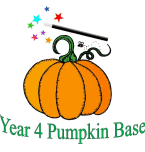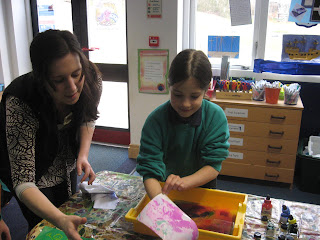This year we created our Easter cards using a marbling effect created by dropping different coloured inks into water. We could change the patterns by gently stirring the mixture.
Aren't they great?
Thursday, 28 March 2013
Science. experiments in water resistance
In our study of forces we have completed an investigation looking at water resistance. We used two plasticene spheres of exactly the same weight. We dropped them at exactly the same time into two identical containers, one was empty but the other contained water.
We found that the sphere dropped quicker in the empty container. The sphere in the water dropped more slowly because although gravity was pulling it down, water resistance acted against this force.
We then wondered what shape would be the most effective in travelling through the water.
We decided to try a cylinder and a cone.
We found that the cone reached the bottom first as the streamlined shape cut most effectivly through the
water resistance.
We found that the sphere dropped quicker in the empty container. The sphere in the water dropped more slowly because although gravity was pulling it down, water resistance acted against this force.
We then wondered what shape would be the most effective in travelling through the water.
We decided to try a cylinder and a cone.
We found that the cone reached the bottom first as the streamlined shape cut most effectivly through the
water resistance.
Sunday, 24 March 2013
Science - Investigating water resistance.
This week we will be exploring why the Viking longships were shaped and made as they were.
Look at this clip to see streamlining in nature and industry.
("Streamlining" is changing the shape of something so that it has as little air or water resistance as possible)
Click HERE to view the clip.
We will see how different shapes are more or less effective at moving through air and water.
Look at this clip to see streamlining in nature and industry.
("Streamlining" is changing the shape of something so that it has as little air or water resistance as possible)
Click HERE to view the clip.
We will see how different shapes are more or less effective at moving through air and water.
Viking Assembly
On Friday 22nd March we presented our assembly all about the formidable force that was the Vikings!
The presentation was supported by an excellent PowerPoint by Jamie, Joe and Nathan.
At the end the parents enjoyed our 'Viking Brooch' biscuits with a nice cup of tea!
The presentation was supported by an excellent PowerPoint by Jamie, Joe and Nathan.
At the end the parents enjoyed our 'Viking Brooch' biscuits with a nice cup of tea!
Sunday, 10 March 2013
History Viking life.
This week we are researching what life might have been like for an early Viking invader.
Here are some film clips to get you started.
To see what life was like travelling on a longship.
To find out more about the raid on Lindisfarne.
Here are some film clips to get you started.
To see what life was like travelling on a longship.
To find out more about the raid on Lindisfarne.
Viking Longhouses
In the next clip the presenter describes what a Viking longhouse was like. Longhouses were usually made of wood, or stone, earth and turf, which kept out the cold better. They had no chimney or windows, so smoke from the open fire drifted out through the roof. Beds and benches lined the walls, and other features included lamps for light, heather bedding, wall hangings and rugs for warmth. In the winter animals slept inside too.Saturday, 9 March 2013
World Book Day
On Thursday we all enjoyed 'World Book Day'. Years 3 and 4 decided to look at the work of Roald Dahl. Year 3 explored the characters in his book 'The Witches', while we looked at 'Fantastic Mr Fox'.
In the morning we examined how Roald Dahl built up the characters of the farmers in his story. We practised finding clues about them using the words in the text but also making deductions through the characters' behaviour and actions. We then created a character of our own using this technique.
Here we are shaing our work with year 3.
In the morning we examined how Roald Dahl built up the characters of the farmers in his story. We practised finding clues about them using the words in the text but also making deductions through the characters' behaviour and actions. We then created a character of our own using this technique.
Here we are shaing our work with year 3.
History. Viking forces
All Viking men learned to fight and use weapons from an early age. They needed these skills to make them successful raiders. They used swords and axes for chopping off their victims heads!
They were so proud of their weapons they gave them special names like 'skull splitter', 'dragon slayer' and 'leg biter'!
They were called 'The Terror of the North'.
Take a look at our display and you will see why!
They were so proud of their weapons they gave them special names like 'skull splitter', 'dragon slayer' and 'leg biter'!
They were called 'The Terror of the North'.
Take a look at our display and you will see why!
Sunday, 3 March 2013
Science Getting to grips with friction
Friction is a force which exists between objects moving across solid surfaces . It opposes motion.
Click HERE to find out how friction affects the speed of a sledge.
Click HERE to test yourself on activities applying what you have learnt about friction.
Click HERE for more explanations about forces, especially for football fans!
Subscribe to:
Posts (Atom)














